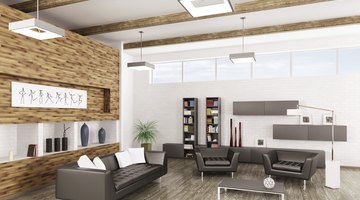Cheap Ceiling Ideas
A home's overhead surface is often overlooked, receiving a ho-hum white-ceiling-paint finish at best. Even when you're working with a tight budget, the vast ceiling area is a blank canvas for multiple wallet-friendly finishes.

Paint, texture, impostor tin and even fabric can provide low-cost character without looking cheap.
Pretty In Paint
Paint is more than wallet friendly; unexpected ceiling color can jazz up a bland room, warm up a visually cold one or heighten a low space. For a room that lacks style, contemplate using metallic paint or a mixed-color pattern over head -- you don't have to have Michelangelo's skill when you have stencils, stamps or templates for making shapes -- or painter's tape to help you form stripes or outlines. To raise a low overhead, keep the ceiling-to-wall contrast low, such as with mid-blue walls that meld into a light-blue overhead surface. The space with an overly high ceiling or daunting openness benefits from a cozy sandwich of pale tan or off-white walls between a warm brown, bronze or charcoal ceiling and richly colored rugs.
Faux Tin Is In
Tin, steel, copper or brass ceiling tiles or panels may be as in style today as they were decades ago, but the faux versions are more in reach of a tight budget. Aluminum, mineral fiber and plastic tiles can cost at least two or three times less than some of their classier counterparts, especially if they're the glue-up style rather than the drop-in type, which require a T-bar hanging system. Although fiber-based tiles hold up well in dry areas, aluminum or plastic tiles are moisture resistant and long lasting in the kitchen or bathroom.
Textbook Texture
If you're a do-it-yourself aficionado, you can cut costs by at least half by learning to texture your ceiling rather than hiring a professional to do it for you. Typically, you can trowel texture or drywall mud over new drywall without first applying primer, but refer to the product's label for specific instructions. Textured paint is another wallet-wise option, and you can relatively easily apply it with a special fabric, stippling or stencil paint roller, making this a more do-it-yourself-friendly project. Apply primer to new drywall before using textured paint.
Finished With Fabric
Flowing fabric hung in swagged or draped fashion from the ceiling adds warmth to a chilly basement, opulence to a dreary den or romance to a boring bedroom. Instead of using costly material, go with ready-made curtains: burlap, tobacco cloth or a dropcloth. If you prefer more color or pizzazz, add a print or pattern to the material with stamps and fabric paint or make stripes using latex paint and painter's tape. No matter what you plan to use to dress up your ceiling, if it's secured safely, suitably stylish and cost efficient -- it can have pleasing results.
The Drip Cap
- A home's overhead surface is often overlooked, receiving a ho-hum white-ceiling-paint finish at best.
- Paint, texture, impostor tin and even fabric can provide low-cost character without looking cheap.
- For a room that lacks style, contemplate using metallic paint or a mixed-color pattern over head -- you don't have to have Michelangelo's skill when you have [**stencils, stamps or templates for making shapes -- or painter's tape to help you form stripes or outlines.
- ]( Aluminum, mineral fiber and plastic tiles can cost at least two or three times less](https://www.thisoldhouse.com/ceilings/21018492/all-about-tin-ceilings) than some of their classier counterparts, especially if they're the glue-up style rather than the drop-in type, which require a T-bar hanging system.
References
Resources
Writer Bio
Lorna Hordos is a home-flipping business owner and freelance writer. She writes friendly, conversational business, home and lifestyle articles for Bizfluent, azcentral, Daltile, Marazzi, Lowes, Philips Lighting, WordPress.com and numerous other publications.
Photo Credits
- Scovad/iStock/Getty Images
- Scovad/iStock/Getty Images
More Articles


